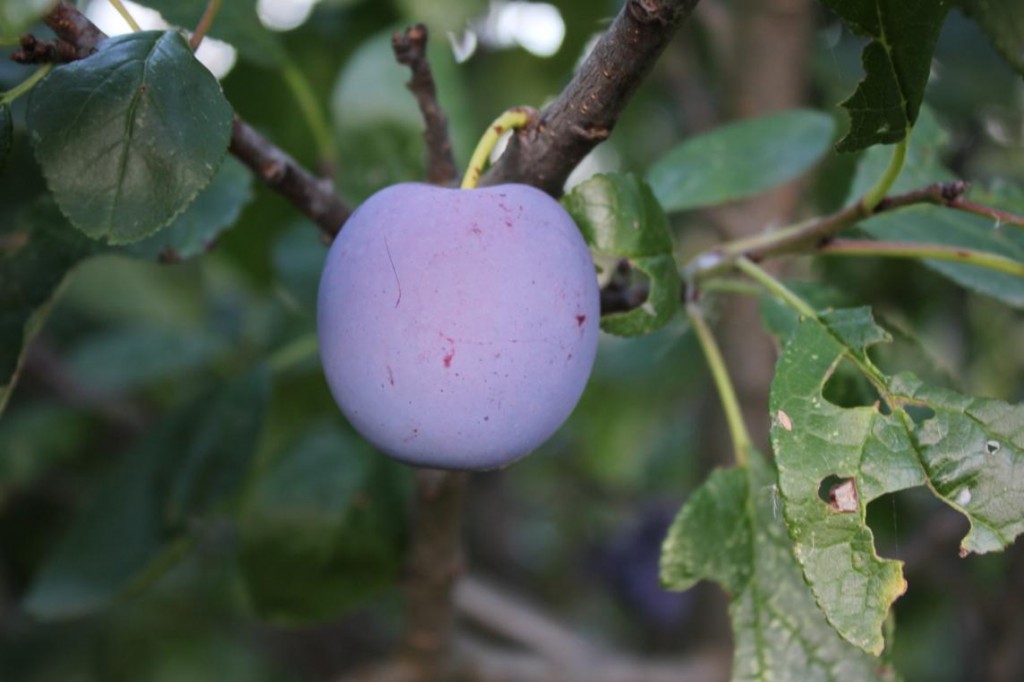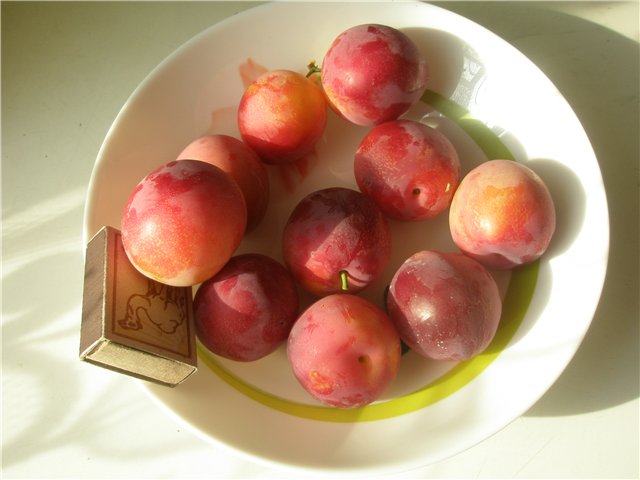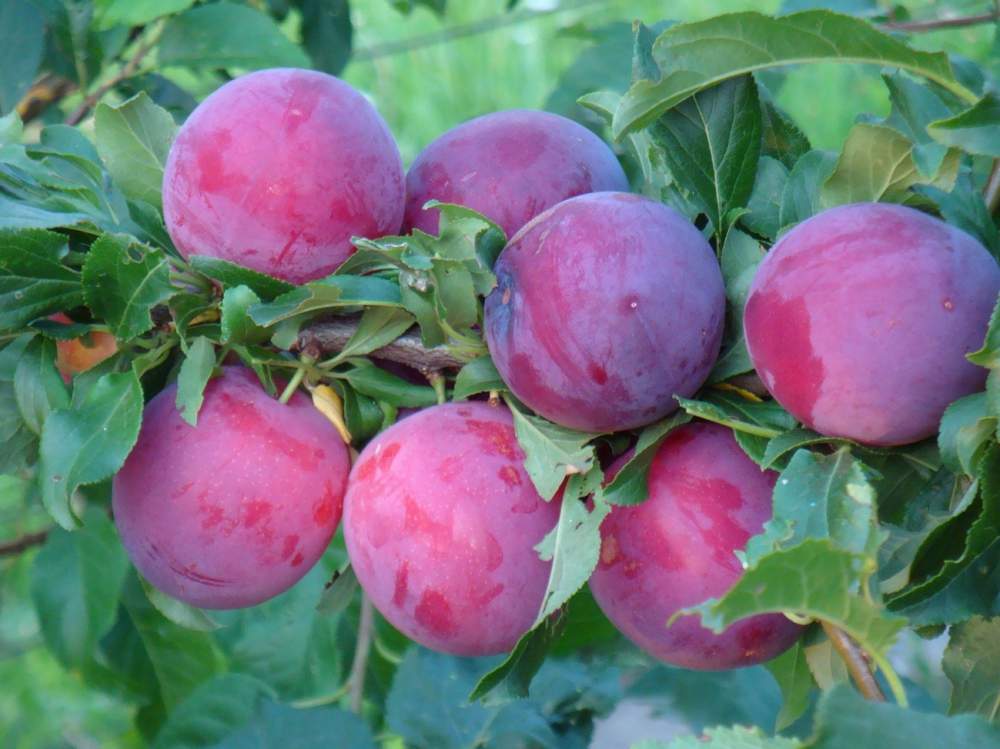Suitable varieties of columnar plum for the Moscow region
Content
Choosing a suitable variety
Trees of columnar varieties, which are characterized by an unusual crown shape, appeared relatively recently. An American breeder noticed an unusual branch on an apple tree, which was thinner and fruited well. The result of several years of attempts to propagate it was the emergence of the columnar variety of the apple tree Vozhak.
After that, scientists managed to bring out pears, and a little later, and plums. The obvious advantages of columnar plums of different varieties can be called the small size of the tree, growing from one and a half to two meters, an underdeveloped crown, an early onset of abundant fruiting (from the second year), good keeping quality of fruits. What varieties of such wonderful plums are recommended today for planting in the Moscow region?
Plum Blue Bird
This variety of plums pleases with its beautiful bright blue fruits. It appeared thanks to the efforts of Crimean scientists, as a result of crossing the Hungarian Caucasian and Kabardian Rannyaya plums. The zoning of this variety, which is perfect for the Moscow region, took place in the North Caucasus. It has rather large fruits, which can weigh up to 45 grams, with a wide oval shape. Due to the special waxy bloom on the surface, fruits that have not yet been picked appear bluish. It has a dense yellow flesh, from which the bone can be easily separated. The plum tastes quite sweet and juicy. It has an average ripening term, its harvest can be harvested somewhere in the middle of August.
The tree has large dimensions, has a somewhat rounded crown, few branches, which allows a large number of fruits to appear, which ripen evenly. Has regular fruiting, fruiting already two years after planting. It is a self-fertile variety, normally tolerates a sharp change in temperature regimes, and exhibits persistent immunity to such dangerous ailments as polystygmosis, moniliosis, clasterosporium.
Plum in Memory of Timiryazev
Another variety that is perfect for the Moscow region is a type of fruit crop that arose from the crossing of such varieties of plums as Skorospelka Krasnaya and Victoria. The size of the fruits can reach 22 grams, they have a characteristic ovoid shape, a yellow rind with a reddish spot. The abdominal suture is practically invisible, and the subcutaneous fibers are red. The pulp has a fine-grained structure. Fruits of medium juiciness, very aromatic and tasty, with a slight sourness. In 100 grams of such fruits, there is approximately 11 mg of ascorbic acid. The ripening period for this variety of plums is rather late, the harvest can be expected at the end of August.
As for the tree, it is medium in size, and the crown has a bushy shape. There are few leaves on it, and the branches are not too densely located. Fruiting occurs on annual shoots. This happens for the first time after about four years. The variety is self-fertile.Has an average yield. For a season, it is possible to collect up to 9 kg of fruits from one tree. Shows good frost resistance, moderate drought resistance and loves thorough watering. In addition, a fruit tree of this variety is able to resist fruit rot and clotterosporium well. Fruiting of such a culture can be periodic.
Plum Smolinka
A variety that is quite popular in Central Russia, and is also well suited for cultivation in the Moscow region. For its appearance, a variety of the fruit tree Ochakovskaya Zheltaya was used, but Smolinka is more like the second variety that was used when crossing - Renklod Ulles. The fruits of such a plum are distinguished by an oval-ovoid shape, and the abdominal suture on their surface is almost invisible. The color of the upper layer of the skin is dark purple, and the cavity has a yellow-greenish tint. Also, the fruits of this type of plum have a pleasant dessert taste and sweet and sour pulp. The ripening period of the fruits is quite early - the harvest can be expected from 14 to 25 August. Well suited for drying, prunes and freezing.
If we talk about the description of a fruit tree, then it can grow up to five and a half meters in height, has an average density and an oval crown. The variety is quite fruitful, it is possible to harvest up to 20 kg of fruit from one tree per season. Begins to bear fruit two years later from the moment of planting. It has an average degree of frost resistance, but at the same time it has the property of quickly recovering in case of negative weather effects. It is not a self-pollinating fruit tree, the poet uses the pollen of such plums as Opal, Superearly, Blue Gift for it. Its branches require the creation of supports, since they can break under the weight of ripe fruits.
In addition to these excellent varieties of plums, there are others - for example, Imperial, one fruit of which can weigh about 55 grams, has a rounded shape and has excellent taste. Imperial is a fairly compact tree, which at the same time has a high yield. The Blue Sweet variety is also good for growing in the Moscow region. It is an oval, slightly flattened cream with a beautiful dark purple color and a sweet and sour pulp taste.
Video "Columnar plum"
How to care for plums of the Moscow region
Plum trees, whether grown on the territory of Russia, Ukraine or other countries, have their own special requirements for planting and care. But today, of course, we will not talk about fruit trees that grow in gardens in Ukraine or other countries, since we are interested in the agricultural technology of plums in the Moscow region.
Such trees, zoned for the Moscow Region Central Region, do not differ much from the others in terms of care requirements.
Pruning is considered to be one of the main points of proper care. It is badly needed by the plum just like the rest of the fruit trees. The only thing is that when pruning, this fruit tree does not require special crown formation. Pruning brings tremendous benefits to trees - it not only stimulates full growth and harmonious development of the tree, but also makes it possible to fight possible dangerous diseases. This is one of the reasons why experts advise to carry out the pruning procedure in the spring, and not before the first frosts come.
Pruning plums must be carried out after the leaves appear on the trees, using a well-sharpened knife for this purpose. You do not need to try to cut a branch with them, you need to cut it off immediately. The main task of every gardener is not only pruning unnecessary, as well as dry and damaged branches, but also carefully carrying out all the manipulations so as not to harm the bark of the tree, as this can lead to the development of diseases.After the pruning has been carried out, the cut points must be thoroughly lubricated using a special garden pitch for these purposes.
Another important measure for the care of plums of columnar varieties is the introduction of the necessary dressings. In principle, plums can grow normally without them, but to obtain a consistently large yield, it is best to apply fertilizers. In the first years after planting trees on your site, this should not be done, since you need to give them the opportunity to normally adapt to new conditions and take root. In the second year of life, it is recommended to feed fruit trees with nitrogen fertilization. They are best applied in the first and second half of June. For 10 liters of water, 2 tablespoons of urea or Ideal liquid should be used.
According to the rules, fertilization must be carried out in three stages. Before the beginning of the flowering period, dig up the ground, moisten it with a nutrient solution - for this, 2 tablespoons of urea per 10 liters of water and potassium sulfate are taken. For one tree of such a solution, approximately 30 liters will be required. The second time, at the moment when the fruit is formed, another solution should be added - for its manufacture, two tablespoons of urea, three tablespoons of nitrophoska per 10 liters of water are taken. For one plant, you will need about 25 liters of the resulting product. The third time feeding is applied after the tree stops bearing fruit. To make it, you need to use two tablespoons of potassium sulfate, three tablespoons of superphosphate per 10 liters of water. For each tree, take about 35 liters of this product.
Also, care measures include preparing trees for wintering. Some disadvantage of this type of plum is that they can rebuke, which in turn will lead to cracking of the bark. Young cultures are not only tied to a peg, but also collect the crown in one bunch. For large trees, each branch should be tied to a sturdy peg.
Watering and planting requirements
When planting such trees on your site, it should be remembered that they need a well-lit place. When planting, it should not be allowed that these plums into the garden are shaded by other trees. Also, when choosing a place for planting, you must prefer a windless piece of land. The drain hole should be prepared in a few weeks, it should be about 60 cm deep, the top layer should be mixed with compost in a ratio of 2 to 1 and laid on the bottom. A peg is also driven in, to which it is imperative to tie the seedling. When planting, it is necessary to check that the root collar remains above the ground by about 5 cm. Since after planting, the soil tends to sink a little. After planting, the tree should be thoroughly watered, and it is best to mulch the soil around it with humus or peat. It is best to plant fruit trees in the spring, although this can be done in the fall.
As for another important measure for the care of such varieties of plum trees - watering - do not forget that the plum is very fond of moisture. Therefore, watering must be carried out regularly, not only in summer, but also in September, in order to avoid cracking the fruits. If watering is carried out in excessive doses, yellowed leaves and dry tops of trees will become a signal. Therefore, watch out for these signs and water your fruit trees competently and rationally.
Video “What a tree looks like”
In the video, you will see a brief overview of how this tree looks like and what features it has.








